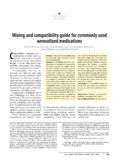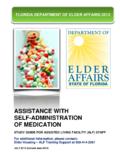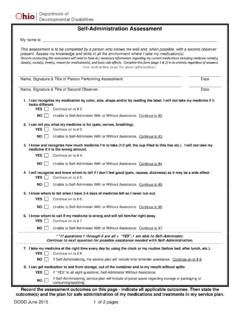Transcription of HOSPITAL: Respiratory Care Services Policy and …
1 B&B HOPE Continuous Medication nebulizer Policy and Procedure 2008 B&B Medical Technologies hospital : Respiratory care Services Policy and Procedure Manual Policy and Procedure Title: HOPE Continuous nebulizer Protocol Area: Respiratory care Services Performed by: Respiratory care Practitioners Policy Number: Approved by: Date: Current Effective Date Approved by: Date: Review Date Approved by: Date: Revised Date Approved by: Date: Policy This Policy assures the standardized use of the HOPE Continuous Medication nebulizer for use in the delivery of aerosolized medications and diagnostic formulations with a 230 ml reservoir. PURPOSE The purpose is to provide for an easily implemented protocol to be used by the Respiratory care Practitioner with effective guidelines and consistent instruction for use in the delivery of continuous nebulization to patients that are in a closely monitored area in the hospital . DEFINITION The HOPE nebulizer is a high output nebulizer to be used to deliver aerosolized medication and diagnostic formulas.
2 It provides additional hydration to help loosen secretions for patients whom therapy is indicated. Heliox, air or oxygen may be added via the multi gas inlet. SETTINGS To ensure patient safety the device is intended to be used under medical supervision in the hospital , emergency department, extended care and inpatient and outpatient clinics. INDICATIONS 1. Provide Long term bronchodilation for patients with serious Asthma, Exacerbation of COPD, Bronchitis and Pneumonia 2. Liquification of thick secretions 3. Improvement of secretion clearance B&B HOPE Continuous Medication nebulizer Policy and Procedure 2008 B&B Medical Technologies EQUIPMENT B&B HOPETM nebulizer (P/N 11310), Oxygen and/or medical grade air at 50 psi, Blender, Oxygen Analyzer with Alarm, Aerosol Tubing, Mask or other delivery device, Cardiac monitor (if indicated) and Pulse Oximeter (if indicated). The B&B Heliox regulator (P/N 11370) can be used for the delivery of 80/20 Helium-Oxygen Gas Mixture.
3 PROCEDURE A: Application/Preparation Steps 1. Therapy should be initiated in the ER, Critical care Unit, and Pediatric Critical Unit or in an area in which the patient's EKG may be monitored continuously. 2. After an order has been received, the therapist is to verify the order in the patient's chart. The treatment must be reordered every 24 hours by a physician. 3. After checking the patient's ID, the therapist is to explain the procedure to the patient and answer any questions the patient may have. 4. Wash hands and assess patient's heart rate, breath sounds, Respiratory rate, peak flow, color, use of accessory muscles, patient's oxygen needs (current ABG) or Sa02. 5. Set up a continuous pulse oximeter to establish baseline saturation and monitor the patient. 6. Attach flowmeter to 50 psi gas source. 7. Attach the HOPE nebulizer to the flowmeter or blender (Figure 2). 8. Attach the corrugated tubing to the HOPE nebulizer output and to the aerosol mask or other delivery device (Figure 1).
4 B: Application/Action Steps 1. PREPARE MEDICATION per protocol of this Policy (Section E). 2. Pour medication into the HOPE nebulizer reservoir using aseptic technique. 3. Set flow meter to 10 liters per minute and adjust Fi02 per chart or Blender to meet patient needs after attaching appropriate size mask to the patient. 4. Monitor the patient for adverse reactions and check the HOPE nebulizer every 30 minutes x 2 hours 5. To determine approximate use of medication, look at the marks on the side of the nebulizer (marks on nebulizer are in 25 ml increments). Adjust the flowmeter by small increments to achieve desired output of 25 ml/hour, without auxiliary flow. 6. When using auxiliary flow output increases. Mix one more hour of medication to accommodate increased output. C: Application/ Patient Assessment 1. Monitor the patient s Pulse before, during treatment, every 30 minutes x 2 hours, then every 2 hours, and post treatment.
5 2. Assess Breath sounds before, during and post treatment. 3. Assess patient with Pulse oximeter before, during and post treatment. 4. In pediatrics, a TCM may be used to monitor patient pre, during and post treatment to monitor PaCO2. 5. Measure Peak Flow rates before treatment, during treatment every hour x2, then every 2 hours and post treatment 6. Measure and quantify Sputum production. 7. Document Subjective statements by patient. 8. Monitor and document patient position, color and level of cooperation. 9. Monitor and document complications or problems noted during therapy. B&B HOPE Continuous Medication nebulizer Policy and Procedure 2008 B&B Medical Technologies 10. Measure and monitor Electrolyte levels at physician discretion, if patient is receiving agonist therapy greater than 4 hours 11. Reevaluate the patient after initial 2 hours of therapy for possible decrease in drug dosage level D: Documentation/Charting1.
6 Check the patient and document the following information every 30 minutes for the first 2 hours, then every 2 hours on the Patient Flow Sheet A. Date and time B. Fi02 C. Heart rate D. Respiratory rate E. Breath sounds F. Oxygen saturation/TCM reading or ETCO2 G. Peak expiratory flow H. Side effects and remarks I. ABG information J. Mental status K. Respiratory care Practitioner signature E: Prepare Medication Protocol This protocol is a guide to the preparation of medication. Physician orders as to medication content and strength must be on the chart prior to start of Continuous Bronchodilator Nebulization Therapy (CBNT). It is inherent to this therapy that the patient may need to have the dosages changed several times after the initiation of this procedure. The therapist must be aware of the signs that indicate the need for dosage change and alert the physician to any change in the patient's status. Guidelines based upon the dosing chart included with the HOPE nebulizer : 1.
7 Initial Gas flow consideration is 10 lpm of 100% source gas driving the nebulizer 2. The medication delivery is based on physician prescription for mg/hr or ml/hr of bronchodilator 3. Mg/hr of medication ordered x = ml of medication used per hour. 4. Output of nebulizer - ml of medication = ml of diluent (normal saline) 5. Multiply diluent and medication times hours you want to deliver; up to 8 hours @ 10 lpm (maximum volume of nebulizer is 220 ml). SAMPLE MEDICATION CALCULATION: SEE Dosing Chart on back of HOPE nebulizer Instruction Sheet. This is a sample calculation. Ideally, when setting up CBNT, the initial fill and dosage should be for 3 hours. MEDICATION + DILUENT = OUTPUT OF nebulizer (25 ml/hr. @ 10 lpm) Albuterol (5 mg = 1 ml, 10 mg=2 ml, 15 mg=3 ml, 20 mg=4 ml) Dosage recommendations Medication Adult Pediatric Albuterol to mg/hour to mg/kg/hour Atrovent to mg/hr B&B HOPE Continuous Medication nebulizer Policy and Procedure 2008 B&B Medical Technologies The use of other than the above bronchodilators for the CBNT for severe bronchospasm should be reviewed by the physician in regards to the following criteria.
8 The ideal drug for this form of therapy has high efficacy with side effects which are both infrequent and benign. The drug may not have metabolites, which are bronchoconstrictors. The pulmonary deposition of drug is dependent upon the following: A. The duration of exposure. B. The drug concentration in the aerosol mist. C. The patient's minute volume and Respiratory rate. D. Other physical factors such as the inspiratory flow rate, airway diameter and route of administration. Initially, patients with severe bronchospasm may have reduced tidal and minute volumes, as well as decreased airway diameters. The reduced volumes in combination with high inspiratory flow rates and narrow airways can lead to a marked reduction in the amount of drug deposited in the lungs. In this situation, a stronger dose is needed to achieve bronchodilation. High doses may lead to side effects as the patient "opens up". When the patient improves, their minute volume and airway diameters may increase and their inspiratory flow rates decrease.
9 The resulting increase in the amount of drug being deposited in the lungs may lead to side effects such as nausea, vomiting, tachycardia and a decreased electrolyte levels (K+ in particular). To avoid this, the patient should be reassessed often and the dose reduced as improvement is noted. F: Contraindications: 1. Absence of the above indications. 2. Increased heart rate of >25 beats or as defined by the physician. G: Treatment Complications: A complete reassessment is indicated any time the patient vomits. Failure may include, but is not limited to the following: 1. Failure to significantly respond in 4 hours. 2. Decreasing aeration over time or increased wheezing without a simultaneous increase in aeration. 3. Worsening blood gases. 4. Decreasing pulse oximeter readings or an increasing need for higher Fi02 s to maintain the same saturation. 5. Increased work of breathing. 6. Anything that leads you to believe, through your patient assessment, that the patient is getting worse.
10 7. When treatment failure is suspected, re-evaluate the patient and contact the physician immediately. H: Precautions and Adverse Events 1. Exhaled aerosol or patient coughing may spread active pulmonary infections. 2. The HOPE nebulizer is intended for single patient use. B&B HOPE Continuous Medication nebulizer Policy and Procedure 2008 B&B Medical Technologies PROCEDURE A. Fi02 CHART IMPORTANT: Use oxygen analyzer to verify Fi02 IMPORTANT: Auxiliary flow increases nebulizer output, mix one more hour of medication. Primary Gas Oxygen at 10 Lpm Primary Gas Air at 10 Lpm Secondary Gas Secondary Gas Air Oxygen FiO2 FiO2 12 Lpm 56% 1 Lpm 28% 8 Lpm 64% 2 Lpm 34% 4 Lpm 77% 3 Lpm 40% 2 Lpm 87% 6 Lpm 50% PROCEDURE A. Heliox Therapy Using 80/20 Heliox: 50% Fi02 50% Helium 1. Set the Primary gas delivery at 10 lpm oxygen. Auxiliary gas 80/20 Heliox at 17 lpm or 15 lpm on the B&B Medical preset Heliox regulator 2.






